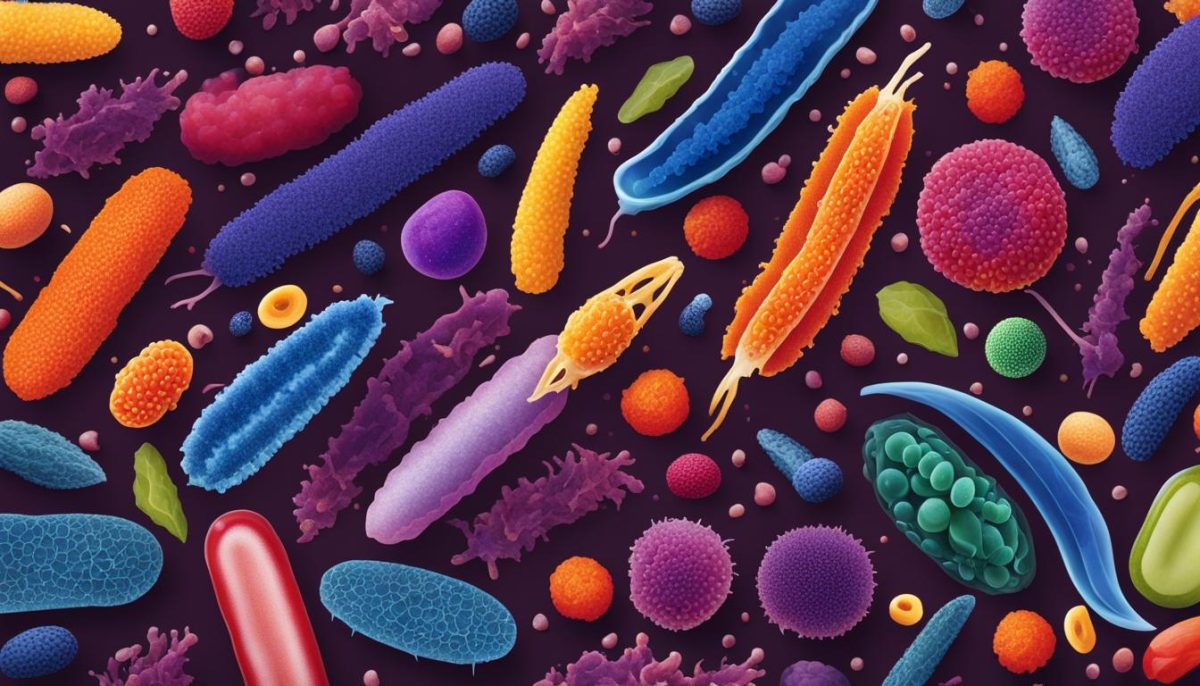Welcome to our exploration of the fascinating world of bacteria and its role in the creation of various food products. In this article, we will delve into the ways bacteria contribute to flavor enhancement and fermentation processes, resulting in the diverse range of tastes and textures we enjoy in our meals.
Bacteria play a crucial role in the development and enhancement of flavors in food products. Specific strains of bacteria, such as lactic acid bacteria, contribute to the tangy flavors found in yogurts and fermented vegetables. Other bacteria, like propionibacteria, are responsible for the nutty and complex flavors found in cheese. By understanding the function of bacteria in flavor development, we gain insights into the richness and variety of taste experiences in different food items.
Bacterial fermentation is another essential process in food production. Through fermentation, bacteria convert sugars into beneficial compounds, resulting in the desired characteristics of the final food products. For example, bacteria are used to ferment milk for yogurt, cabbage for sauerkraut, and grapes for wine. By delving into the world of bacterial fermentation, we gain a deeper understanding of the complexity and artistry behind our favorite food items.
So, join us on this enlightening journey as we explore the crucial role of bacteria in the creation of a variety of food products. Let’s uncover the science and artistry behind the flavors and textures we savor in our everyday meals.
Bacteria and Flavor Enhancement in Food Products
In the world of food production, bacteria don’t just play a supporting role; they are the secret ingredient behind the incredible flavors we enjoy. From tangy yogurts to nutty cheeses, bacteria contribute to the development and enhancement of flavors in a wide variety of food products.
One of the key players in flavor enhancement is lactic acid bacteria. These bacteria have a unique ability to convert sugars into lactic acid through a process called fermentation. This tangy byproduct gives yogurts and fermented vegetables their distinct flavors. These bacteria are also responsible for the delightful tang in sauerkraut and the zesty kick in kimchi.
Another group of bacteria that significantly impact flavor are propionibacteria. These bacteria are commonly found in cheese production and contribute to the nutty and complex flavors we adore. Propionibacteria break down lactic acid into carbon dioxide, propionic acid, and acetic acid during the ripening process, creating the distinctive flavor and texture of certain cheeses like Gruyere and Emmental.
By understanding the critical role of bacteria in flavor development, we gain insights into the diversity of taste experiences in different food products. The precise strains of bacteria used in each food production process, combined with specific fermentation techniques, result in a wide range of flavors that delight our taste buds.
The Impact of Bacteria on Flavor:
- Bacteria contribute to tangy flavors in yogurts and fermented vegetables.
- Specific bacterial strains, such as lactic acid bacteria, are responsible for creating these flavors.
- Propionibacteria play a crucial role in developing nutty and complex flavors in certain cheeses.
- The fermentation processes driven by bacteria result in a diverse range of flavors in food products.
- Understanding bacteria’s role in flavor enhancement enhances the culinary experience for consumers.

As we continue to explore the complex and fascinating world of food production, the role of bacteria becomes increasingly apparent. Bacteria not only contribute to flavor enhancement but also play a vital role in fermentation, which we will explore further in the next section.
Bacterial Fermentation in Food Production
Bacterial fermentation plays a crucial role in the creation of a wide variety of food items. It is a process that utilizes the power of beneficial bacteria to transform different ingredients into delicious and nutritious products. From yogurt, sauerkraut, to wine, bacterial fermentation is the driving force behind their distinct flavors and characteristics.
During the fermentation process, specific bacterial strains convert sugars present in the ingredients into beneficial compounds. For example, when milk undergoes bacterial fermentation, lactic acid bacteria transform lactose into lactic acid, giving yogurt its tangy taste and smooth texture. Similarly, the cabbage used in sauerkraut fermentation is transformed by lactic acid bacteria, resulting in its signature sour flavor and crunchy texture.
In the production of wine, certain strains of bacteria, such as Oenococcus and Lactobacillus, are responsible for converting grape sugars into alcohol and other flavor compounds. This microbial transformation gives wine its distinct aroma, complexity, and character.
Understanding the role of bacterial fermentation in food production allows us to appreciate the intricate processes and techniques that bring forth a diverse range of flavors and textures. From the tang of yogurt to the sourness of sauerkraut and the complexity of wine, bacteria are the unsung heroes shaping our culinary experiences.